On this page
The Birds of Africa
(G.E. Shelley)This page lists the volumes of the Birds of Africa written by G.E. Shelley and published between 1896 and 1912. The last published volume was completed by W.L. Sclater.Four or five further volumes were planned but were not produced. Shelley described the region covered by the work as the "Ethiopian Region". He defined this as being all of Africa plus Atlantic islands (Cape Verde, St. Helena) and Indian Ocean islands (Madagascar, Seychelles).
Africa
For other books about birds of Africa and African countries see:
- Africa
For the UK and US edition of the modern Birds Of Africa series see:
- Birds Of Africa (Poyser)
- Birds Of Africa (Princeton)
|
|
|
|
The Birds of AfricaComprising All The Species Which Occur In The Ethiopian RegionVolume V, Part IIPasseriformes (continued)G.E. Shelley
Completed and edited by W. L. Sclater
8 colour plates: Henrik Gronvold
Henry Southeran & Co
1912
Prefatory note: The present instalment completes the fifth volume of the late Captain Shelley's great undertaking. Soon after the appearance of the first part of the present volume in 1906, the author was struck down by a sudden illness - a stroke of paralysis - and although he lived on till November 29, 1910, he was unable to continue his labours. The completion of his work, however, was constantly in his thoughts, and shortly before his death I was asked by Mrs. Shelley if I would undertake this task. It was not, however, until afterwards, in the middle of last year, that the arrangements could be made for doing so. Mrs. Shelley then handed over to me all the MSS. and the proofs of four sheets which were already in type. The plan and arrangement of the present part is mainly that of the late Captain Shelley, and my task has been to supply descriptions of some of the species, many of which were very incomplete, to revise the whole in the light of the additional facts and discoveries of the last six years, and to pass the work through the press. I am indebted to my father, Mr. P. L. Sclater, for having read through the proofs for me, and to Mr. Ogilvie Grant for much help and many facilities afforded to me in the Bird Room at the British Museum. It is hoped that the work may be completed in four or five more volumes."
|
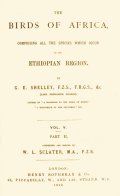
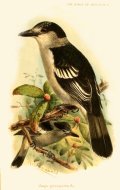
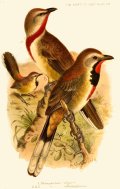 |
|
The Birds of AfricaComprising All The Species Which Occur In The Ethiopian RegionVolume V, Part IPasseriformes (continued)G.E. Shelley
7 colour plates: Henrik Gronvold
R.H. Porter
1906
No preface or introduction. Example text from first species described (Oriolus galbula): The European Golden Oriole breeds during its migration in Europe and Western Asia, and has been met with as far north as 60° N. lat. It ranges over the whole of Eastern and Southern Africa, and North-western Africa to as far south as Senegambia. The greater portion of the specimens migrate from Africa in April, and return to that continent again in September, but some apparently remain in Tropical Africa throughout the year, for Dr. Hinde procured an example at Nairobi, on June 1, 1899. It has not been recorded from Western Africa, between Senegambia and Damaraland, so it apparently migrates from the latter country and Cape Colony, through the eastern side of the continent, and according to Hartlaub (Vog. Madag., 1877, p. 159), has been met with on the island of Madagascar in October. When I was in Egypt these Orioles were first seen on April 20, and soon became plentiful in parties of five or six, all hurrying northward on their migration. They are shy birds, and naturally keep to the thickest foliaged trees they meet with, so consequently are not easy to observe, but may be attracted into view by imitating their loud flute-like note, which has been compared to the words, "Who are you," which is an appropriate remark for these birds to make, as they are very wary and careful not to show themselves in dangerous company. Mr. Dresser gives good figures of the adult male and female (Birds of Europe, iii., p. 3G5, pi. 144) and writes: "It devours all sorts of insects that inhabit the woodlands, but is especially fond of the large green caterpillars which are found on the leaves of the trees. It also feeds largely on berries and fruit when in season, but is not more destructive in a garden than many other birds, and amply repays any mischief it may do by the number of noxious insects it kills. It is most partial to cherries, of all garden-fruit, but will also feed on currants, and especially on mulberries."
|

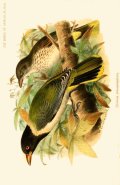
 |
|
The Birds of AfricaComprising All The Species Which Occur In The Ethiopian RegionVolume IV, Part IIPasseriformes (continued)G.E. Shelley
7 colour plates: Henrik Gronvold
R.H. Porter
1905
No preface or introduction. Example text from first species described (Spermospiza haematina): Verreaux received the species from Casamanse, and Brogden met with it at Sierra Leone; here Mr. Kemp procured speci mens from March to October at Rotifunk, Jagbamah and Bo, and writes: "It frequents the farms and marshy ground like Pyrpnestes coccineus, is very wary and as difficult to see as that bird, and like that species apparently breeds here in August and September." Dr. Biittikofer found its nest in Liberia and remarks that it does not breed in colonies. The nest was placed in the fork of a bush, some four feet from the ground, in the undergrowth of the forest, and was spherical in form, about five inches in diameter, with the entrance near the top, and was constructed of soft grass without any lining, and contained two white eggs, measuring 0.76 x 0.52. He remarks that in one of his male specimens the upper tail-coverts were broadly edged with red; probably this was the remains of the immature plumage, for it appears to me that both sexes, when young, have the same amount of dull red on the upper tail- coverts ; but unfortunately the sex has not been recorded of any of the immature birds I have examined. The species is fairly distributed throughout Liberia and the Gold Coast, and is represented in the British Museum from Sierra Leone, Ashantee, Wassaw, Denkera Forest, Cape Coast, Accra and Abeokuta, but as it lives in pairs in the thick bush and forest country, is only occasionally seen. On the Gold Coast, in March, Buckley and I found them frequenting the dense bush, appearing at times singly or in pairs on the narrow footpaths.
|

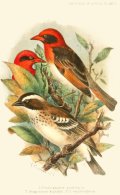
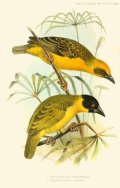 |
|
The Birds of AfricaComprising All The Species Which Occur In The Ethiopian RegionVolume IV, Part IPasseriformes (continued)G.E. Shelley
7 colour plates: Henrik Gronvold
R.H. Porter
1905
No preface or introduction. Example text from first species described (Linurgus concolor): The Great Brown Short-tailed Finch is confined to the Island of St. Thomas. The species was discovered by Mr. F. Newton, who informs us that it is known to the natives of the island as the "Enjolo." On the east coast he procured two specimens at the Rio Quija, which runs through the large forest at Angolares, and he observed it on the west coast at St. Miguel. I overlooked the affinities of this bird when I published my third volume of the "Birds of Africa," presuming that it had been rightly assigned to the genus Amblyospiza, where it remained until Count Salvadori pointed out that it is a true Finch, and proposed to make it the type of a new genus Neospiza (Ace. R. Sc. Torino, 1903, p. 26). This species appears to me not to be generically distinct from Linurgus rufibrunneus, Gray, and Phseospiza thomensis, Bocage, both of which I have referred to the genus Linurgus, Reichenbach.
|
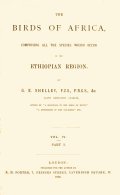

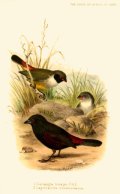 |
|
The Birds of AfricaComprising All The Species Which Occur In The Ethiopian RegionVolume IIIPasseriformes (continued)G.E. Shelley
14 colour plates: Henrik Gronvold
R.H. Porter
1902
No preface or introduction. Example text from first species described (Macronyx capensis): The Cape Long-claw ranges from Cape Colony into Zululand and Mashona. I met with the species near both Cape Town and Durban, singly or in pairs. They appear never to assemble in flocks, but to be very generally distributed over suitable country, such as the open veldt which is here and there interspersed with bushes and ant-hills, on the tops of which they immediately perch when disturbed. No doubt on account of this habit Levaillant called the species "L'Alouette Sentinelle," a more euphonious name than "Cut-throat Lark" or "Kalksentje;" by which they are generally known to the colonists. Like the other members of the genus Macronyx, it is partial to certain localities, for Layard writes: "Mr. W. Atmore declares that it is never found on Karroo soil, and we do not remember noticing it near Beaufort; certainly it is not recorded in Victorin's collections from the Karroo, though he appears to have met with it plentifully in the Knysna district." The species is common in Southern Cape Colony, Natal, Zululand and the Transvaal; but according to Dr. Bradshaw it is not found along the northern border of Cape Colony, and it has never been recorded from so far north as the Zambesi River.
|
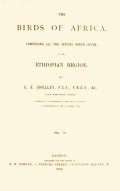
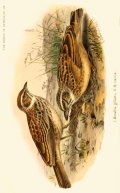
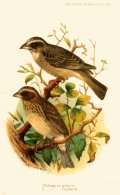 |
|
The Birds of AfricaComprising All The Species Which Occur In The Ethiopian RegionVolume IIPasseriformesG.E. Shelley
14 colour plates: Henrik Gronvold
R.H. Porter
1900
From the preface: When I published the first volume of The Birds of Africa I had sketched out the classification down to the Keys of the Species, and intended to bring this out as the second volume; but the number of known Ethiopian forms increases so rapidly that I recognised how imperfect these keys would be by the time I came to write the history of the species, so decided to work out each family in a monographic form. The Classification is compiled mostly from Seebohm's Classification of Birds (1890), and that proposed by Dr. R. B. Sharpe at the Ornithological Congress, Buda-Pest, 1891, and I have followed these authors in the use of the termination 'formes' for the seventeen large divisions which I call Orders. I begin with the Passeriformes and follow on with the Piciformes. The two families of these separate orders which appear to me to be most nearly allied are the Swallows and the Swifts, so as I end the Passeriformes with the Hirundinidas it entails beginning the classification with the Oligomyodse. The Oligomyodse lead most naturally into the Oscinen through the Madagascar genera Philepitta and Neodrepanis; therefore I commence the Oscines with the Nectariniidas. With regard to the synonymy of the species: I begin with what I consider to be the most correct name; quote the Catalogue of the Birds of the British Museum, where full synonymy is given in detail, and add only such references which have not appeared in that great work.
|

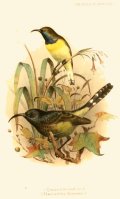
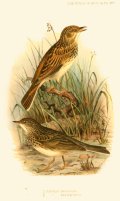 |
|
The Birds of AfricaComprising All The Species Which Occur In The Ethiopian RegionVolume I: ListG.E. Shelley
R.H. Porter
1896
196 pages covering 2,534 species. There are no illustrations in this volume.
From the introduction: The present work, which I shall call the Birds of Africa, will, I hope, consist of a series of handy volumes complete in themselves. Thus the first will comprise a list of all the species known to occur in the Ethiopian Region, up to the time of publication, with a reference to a good figure and to the page and volume of the Catalogue of the British Museum where the species is mentioned, while their geographical distribution will be indicated by the initial letters of the subregions in which they are known to occur. This volume may in fact be called a Nomenclator Avium Aethiopicarum. Vol. II. will be devoted to the classification and diagnosis of all the species, and, I trust, will be an acceptable work to the Field Naturalist, for whom many of the notes will be specially intended. The preparation of this volume has involved the adoption of a classification in some few details differing from those of my predecessors; but it may be hoped that Vol. II. will fully explain my reasons for following the order adopted in this first volume. The Ethiopian Region, as I understand it, comprises Africa and the surrounding seas south of the Tropic of Cancer, including the islands of Cape Verde and St. Helena in the Atlantic, Crozet and Marion Islands in the Southern Ocean, and eastward as far as Rodriguez Island in 65° E. long., including Madagascar, the Seychelles Archipelago, the island of Socotra, and the whole of the Red Sea.
|
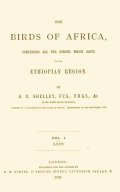
 |
|